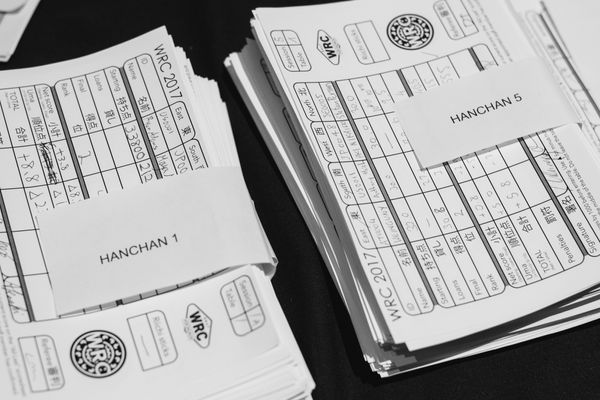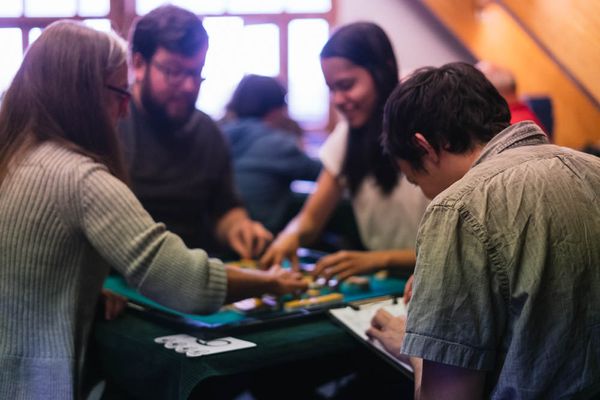fso's live adventures: A visit to the local mahjong group, Lirma

After Senechal discovered – in denmark – that there’s a newly founded group of people playing where I live, I decided to pay them a visit. So far I’ve been there four times total and upon that discovery, osamu promptly gaped at me to write about it. So I did.
Lirma being made up almost exclusively by students, it makes sense for the playing area to be somewhere in the university. On Sundays however, you need a student ID to actually get inside and so I found myself standing just outside the closest entrance to the designated room, with a bag from McDonald’s in my left hand (so that I don’t go hungry as the hours pass by) looking for someone to let me in. Fortunately though, even on Sundays the university has plenty of people around and after barely half a minute a girl lugging around an instrument her own size opened the door for me, and I appropriately prepared myself to walk around hopelessly lost trying to find where that particular room is. Despite my expectations, finding it turned out to be easy, even though I have no sense of direction and decided to be too much of a bloke to ask for directions, the map on their website describes its position well and it’s really just a simple matter of getting inside the university at the proper entrance, and taking a left. Unless someone mucked up and forgot to book the room, in which case the nearby kitchen proved to be a valid alternative. As I entered the room, I found a row of coat hangers to my right, and two of the members to my left, one of them studying. After hanging my coat and placing my still warm bag filled with cheeseburgers on a nearby table, I greeted the students and proceeded to stand around, taking it easy as I waited for more people to turn up. And so they did; some by their own accord and others seemingly woken up as the time slowly went past four in the afternoon. As people dropped in, a few brought things along with them; necessities such as mahjong sets, a cloth to slam the tiles on and tea for everyone to drink. On my very first visit, someone even brought cookies. And as you’d expect from students, there seems to always be at least one person missing due to getting plastered the night before and finding himself unable to get out of bed to join the rest of us.
Once things get going and tiles are slammed, the first obvious question that comes to mind is how the ambiance is; with hungover students, complete beginners and myself at the same table surely some problems must arise. However, even with my smug self counting for everyone else, the occasional rule argument discussion and even a certain person implying I might want to cheat, as far as I could tell, good times were had by everyone attending. Tea most certainly helped here. What really made a difference though was whether or not to use the rather thick and somewhat nappy cloth. Without it, the wooden tables delivered a rather as-you’d-expect loud bang as tiles were discarded on it. Whereas by using the cloth, not only did it get slightly trickier to handle the tiles but the sound was almost completely absorbed. And not just from the tiles. Interestingly, I found that without the cloth, the table would be surrounded by constant chatter filled with sassy remarks and game related comments, while using the cloth almost killed it completely. On the occasion that someone dares break the silence, it would be with a faint whisper before a more conversation friendly volume was reached, and soon after, once several words had been exchanged back and forth and both parts were content, silence returned, eagerly awaiting the next whisper. The group has ordered a few new sets and are planning to get a decent cloth so any further writing on that subject from my part is a waste of effort, so…
As for notable hands, I could write about my getting shou san gen twice, but the most noteworthy hands I’ve seen so far were in the first hanchan I played on my very first visit. After the first hand ended with ryuukyoku, the following two had someone with either one tile too many or one too few. With one person looking over toimen’s shoulder to give him hints where he probably didn’t need it, there was one particular hand where having him there saved him from first doing a noten riichi, and soon after a hopeless furiten riichi. I don’t remember any hands beyond that, but this had set the bar. Right off the bat I got the impression that I was mostly dealing with complete beginners. While there are a few beginners attending, that hanchan turned out to be an exception rather than the norm and while I wouldn’t say that the skill level is high amongst the members, it’s most certainly enough to enjoy a few (or several, if people feel like it) games while sipping tea and in general having a good time. I’m not even all that bothered by having to play with the EMA ruleset. I don’t like it, sure, but the good points makes up for it.
Once a game is finished, scores are entered in a computer (or phone, whichever is closest at hand) and stored. That’s it. Since the first time I visited, there’s been some talk about doing something to display the statistics gathered every week so that you are able to see how you’ve been doing over the course of however long you’ve been going there, that it would be easy to do so and yet, to my knowledge, nothing has been done. Anyway, once games have been played and people have had it for the day, teacups are assembled, mahjong sets are put back into their intended vessel and tables are arranged in the order they were when we arrived, people scatter and I make my way back home feeling it was time well spent, returning next the week after for more blithe, easy (but no less engaging) mahjong with the locals. Oh, and here’s their website: http://lirma.studorg.liu.se/.



